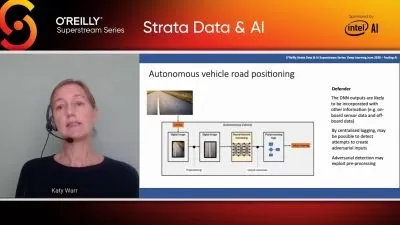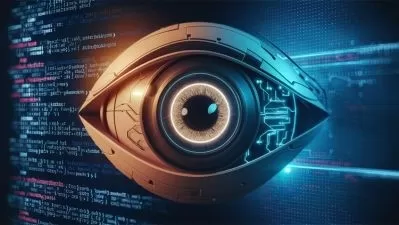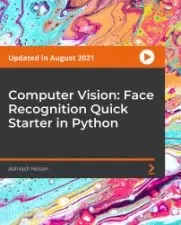New Deep Learning for Computer Vision with Tensorflow 2.X
CARLOS QUIROS
10:36:50
Description
Updated version of the previous course. Contains new SOTAs such as Vision Transformer, YOLOv7 and U-Net
What You'll Learn?
- The application of deep learning in computer vision field
- The course is focused on image classification and object detection
- We'll review the main state of the art algorithms
- We'll develop several practical applications such as detecting Covid19 and License Plate Recognition
Who is this for?
What You Need to Know?
More details
DescriptionThis new course is the updated version of the previous course Deep Learning for Computer Vision with Tensorflow2.X.
It contains new classes explaining in detail many state of the art algorithms for image classification and object detection.
The course was entirely written using Google Colaboratory(Colab) in order to help students that don't have a GPU card in your local system, however you can follow the course easily if you have one.
This time the course starts explaining in detail the building blocks from ConvNets which are the base for image classification and the base for the feature extractors in the latest object detection algorithms.
We're going to study in detail the following concepts and algorithms:
- Image Fundamentals in Computer Vision,
- Load images in Generators with TensorFlow,
- Convolution Operation,
- Sparsity Connections and parameter sharing,
- Depthwise separable convolution,
- Padding,
- Conv2D layer with Tensorflow,
- Pooling layer,
- Fully connected layer,
- Batch Normalization,
- ReLU activation and other functions,
- Number of training parameters calculation,
- Image Augmentation, etc
- Different ConvNets architectures such as:
 * LeNet5,
 * AlexNet,
 * VGG-16,
 * ResNet,
 * Inception,
 * The lastest state of art Vision Transformer (ViT)
- Many practical applications using famous datasets and sources such as:
 * Covid19 on X-Ray images,
 * CIFAR10,
 * Fashion MNIST,
 * BCCD,
 * COCO dataset,
 * Open Images Dataset V6 through Voxel FiftyOne,
 * ROBOFLOW
In the Object Detection chapter we'll learn the theory and the application behind the main object detection algorithms doing a journey since the beginnings to the latest state of the art algorithms.
You'll be able to use the main algorithms of object detection to develop practical applications.
Some of the content in this Chapter is the following:
- Object detection milestones since Selective Search algorithm,
- Object detection metrics,
- Theoretical background for R-CNN, Fast R-CNN and Faster R-CNN,
- Detect blood cells using Faster R-CNN application,
- Theoretical background for Single Shot Detector (SSD),
- Train your customs datasets using different models with TensorFlow Object Detection API
- Object Detection on images and videos,
- YOLOv2 and YOLOv3 background.
- Object detection from COCO dataset application using YOLOv4 model.
- YOLOv4 theoretical class
- Practical application for detecting Robots using a custom dataset (R2D2 and C3PO robots dataset) and YOLOv4 model
- Practical application for License Plate recognition converting the plates images in raw text format (OCR) with Yolov4, OpenCV and ConvNets
-Object detection with the latest state of the art YOLOv7.
-Face Mask detection application with YOLOv7
I have updated the course with a new chapter for Image Segmentation:
- I review the theory behind U-Net for image segmentation
- We develop an application for detecting brain tumors from MRI images using U-Net.
- We train models with U-Net and U-Net with attention mechanism.
You will find in this course a concise review of the theory with intuitive concepts of the algorithms, and you will be able to put in practice your knowledge with many practical examples using your own datasets.
This new course represents a huge improvement of the previous course, however the previous course was very well qualified by the students, some of the inspiring comments are here:
* Maximiliano D'Amico (5 stars): Very interesting and updated course on YOLO!
* Stefan Lankester (5 stars): Thanks Carlos for this valuable training. Good explanation with broad treatment of the subject object recognition in images and video. Showing interesting examples and references to the needed resources. Good explanation about which versions of different python packages should be used for successful results.
* Shihab (5 stars): It was a really amazing course. Must recommend for everyone.
* Estanislau de Sena Filho (5 stars): Excellent course. Excellent explanation. It's the best machine learning course for computer vision. I recommend it
* Areej AI Medinah (5 stars): The course is really good for computer vision. It consists of all material required to put computer vision projects in practice. After building a great understanding through theory, it also gives hands-on experience.
* Dave Roberto (5 stars): The course is completely worth it. The teacher clearly conveys the concepts and it is clear that he understands them very well (there is not the same feeling with other courses). The schemes he uses are not the usual ones you can see in other courses, but they really help much better to illustrate and understand. I would give eight stars to the course, but the maximum is five. It's one of the few Udemy courses that has left me really satisfied.
Who this course is for:
- Intermediate level users who want to learn about the latest SOTA algorithms
- Users who want to learn in a concise way the theory behind the main SOTA algorithms
- Users who want to learn how to implement practical apps for object detection and image classification
This new course is the updated version of the previous course Deep Learning for Computer Vision with Tensorflow2.X.
It contains new classes explaining in detail many state of the art algorithms for image classification and object detection.
The course was entirely written using Google Colaboratory(Colab) in order to help students that don't have a GPU card in your local system, however you can follow the course easily if you have one.
This time the course starts explaining in detail the building blocks from ConvNets which are the base for image classification and the base for the feature extractors in the latest object detection algorithms.
We're going to study in detail the following concepts and algorithms:
- Image Fundamentals in Computer Vision,
- Load images in Generators with TensorFlow,
- Convolution Operation,
- Sparsity Connections and parameter sharing,
- Depthwise separable convolution,
- Padding,
- Conv2D layer with Tensorflow,
- Pooling layer,
- Fully connected layer,
- Batch Normalization,
- ReLU activation and other functions,
- Number of training parameters calculation,
- Image Augmentation, etc
- Different ConvNets architectures such as:
 * LeNet5,
 * AlexNet,
 * VGG-16,
 * ResNet,
 * Inception,
 * The lastest state of art Vision Transformer (ViT)
- Many practical applications using famous datasets and sources such as:
 * Covid19 on X-Ray images,
 * CIFAR10,
 * Fashion MNIST,
 * BCCD,
 * COCO dataset,
 * Open Images Dataset V6 through Voxel FiftyOne,
 * ROBOFLOW
In the Object Detection chapter we'll learn the theory and the application behind the main object detection algorithms doing a journey since the beginnings to the latest state of the art algorithms.
You'll be able to use the main algorithms of object detection to develop practical applications.
Some of the content in this Chapter is the following:
- Object detection milestones since Selective Search algorithm,
- Object detection metrics,
- Theoretical background for R-CNN, Fast R-CNN and Faster R-CNN,
- Detect blood cells using Faster R-CNN application,
- Theoretical background for Single Shot Detector (SSD),
- Train your customs datasets using different models with TensorFlow Object Detection API
- Object Detection on images and videos,
- YOLOv2 and YOLOv3 background.
- Object detection from COCO dataset application using YOLOv4 model.
- YOLOv4 theoretical class
- Practical application for detecting Robots using a custom dataset (R2D2 and C3PO robots dataset) and YOLOv4 model
- Practical application for License Plate recognition converting the plates images in raw text format (OCR) with Yolov4, OpenCV and ConvNets
-Object detection with the latest state of the art YOLOv7.
-Face Mask detection application with YOLOv7
I have updated the course with a new chapter for Image Segmentation:
- I review the theory behind U-Net for image segmentation
- We develop an application for detecting brain tumors from MRI images using U-Net.
- We train models with U-Net and U-Net with attention mechanism.
You will find in this course a concise review of the theory with intuitive concepts of the algorithms, and you will be able to put in practice your knowledge with many practical examples using your own datasets.
This new course represents a huge improvement of the previous course, however the previous course was very well qualified by the students, some of the inspiring comments are here:
* Maximiliano D'Amico (5 stars): Very interesting and updated course on YOLO!
* Stefan Lankester (5 stars): Thanks Carlos for this valuable training. Good explanation with broad treatment of the subject object recognition in images and video. Showing interesting examples and references to the needed resources. Good explanation about which versions of different python packages should be used for successful results.
* Shihab (5 stars): It was a really amazing course. Must recommend for everyone.
* Estanislau de Sena Filho (5 stars): Excellent course. Excellent explanation. It's the best machine learning course for computer vision. I recommend it
* Areej AI Medinah (5 stars): The course is really good for computer vision. It consists of all material required to put computer vision projects in practice. After building a great understanding through theory, it also gives hands-on experience.
* Dave Roberto (5 stars): The course is completely worth it. The teacher clearly conveys the concepts and it is clear that he understands them very well (there is not the same feeling with other courses). The schemes he uses are not the usual ones you can see in other courses, but they really help much better to illustrate and understand. I would give eight stars to the course, but the maximum is five. It's one of the few Udemy courses that has left me really satisfied.
Who this course is for:
- Intermediate level users who want to learn about the latest SOTA algorithms
- Users who want to learn in a concise way the theory behind the main SOTA algorithms
- Users who want to learn how to implement practical apps for object detection and image classification
User Reviews
Rating
CARLOS QUIROS
Instructor's Courses
Udemy
View courses Udemy- language english
- Training sessions 55
- duration 10:36:50
- Release Date 2024/03/11














